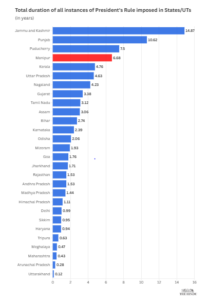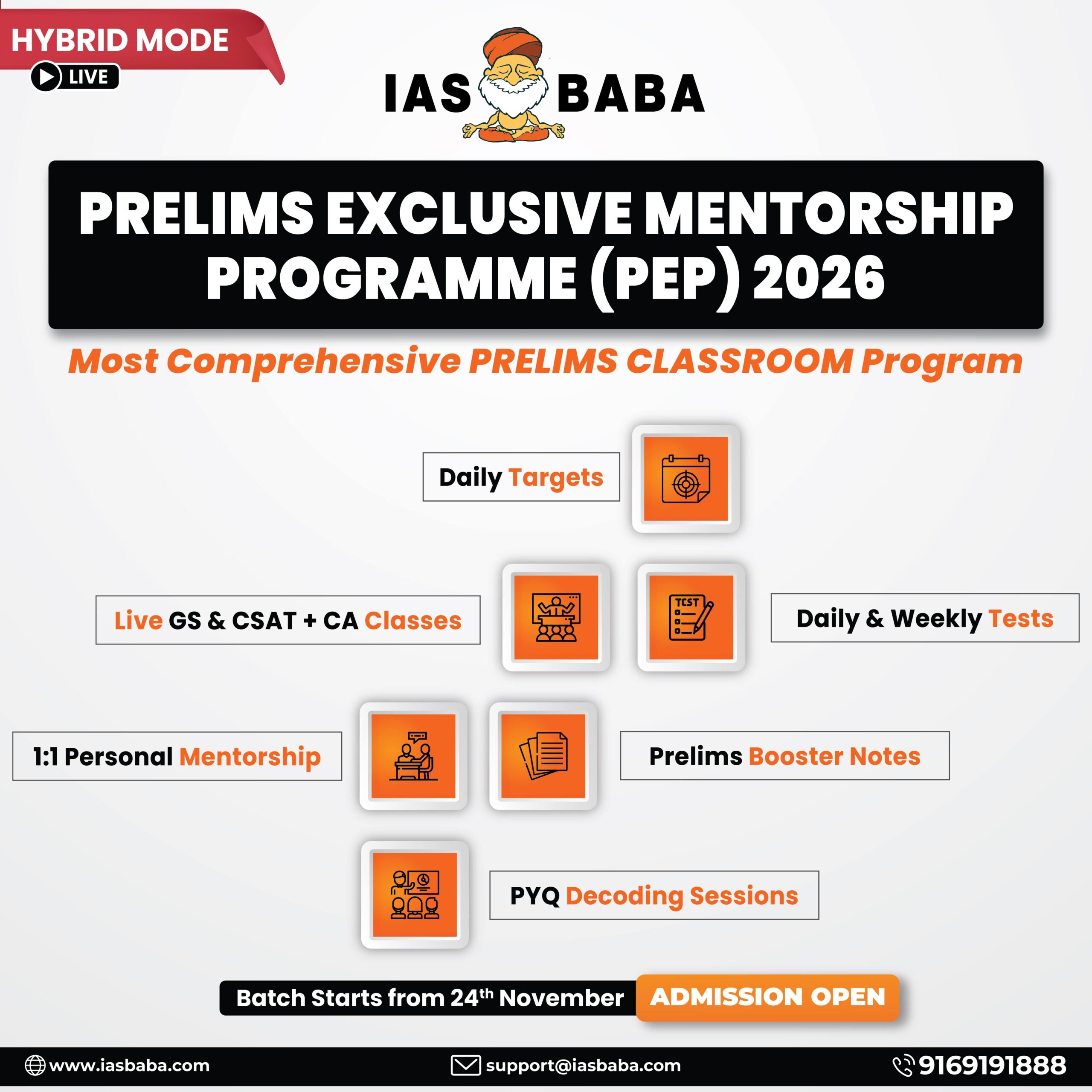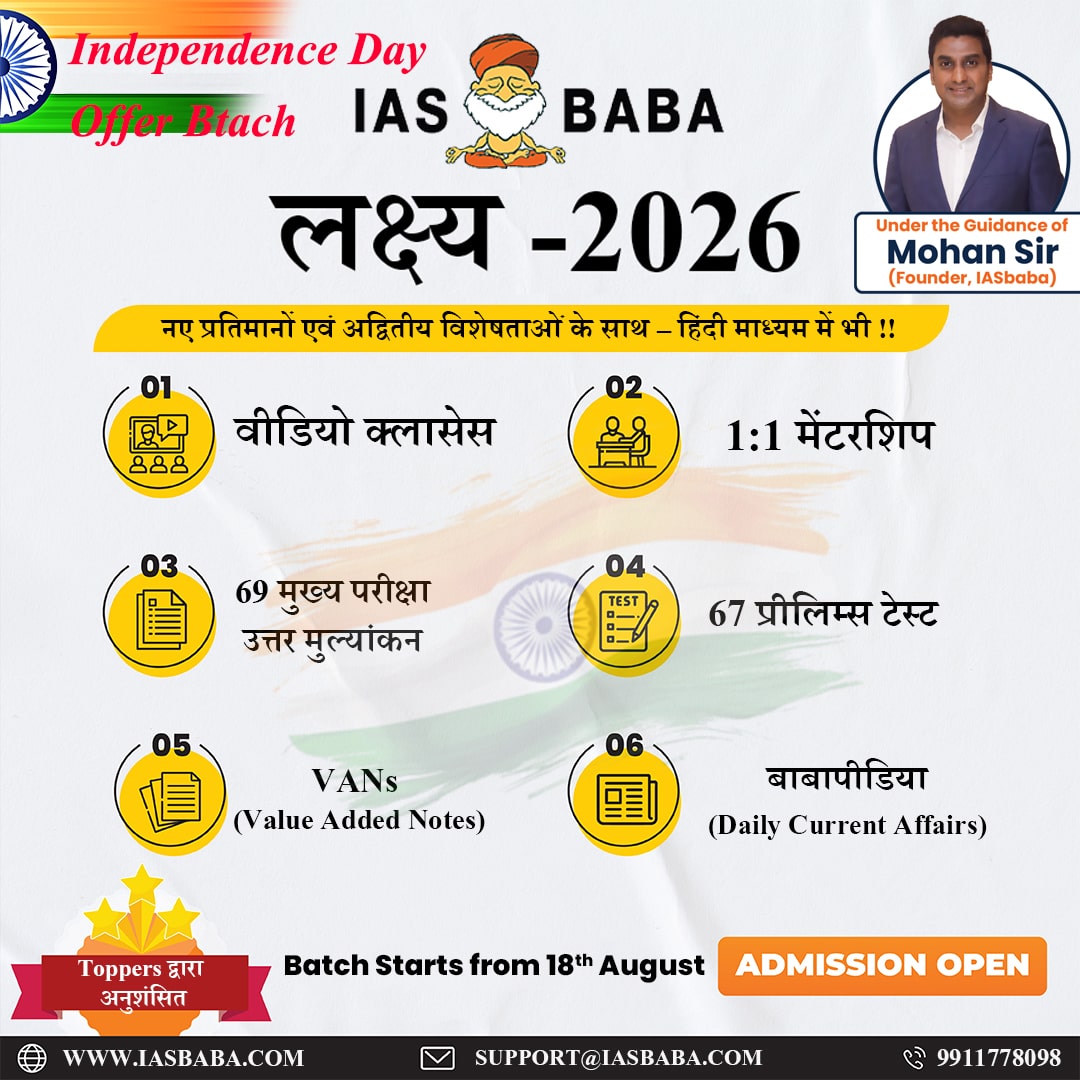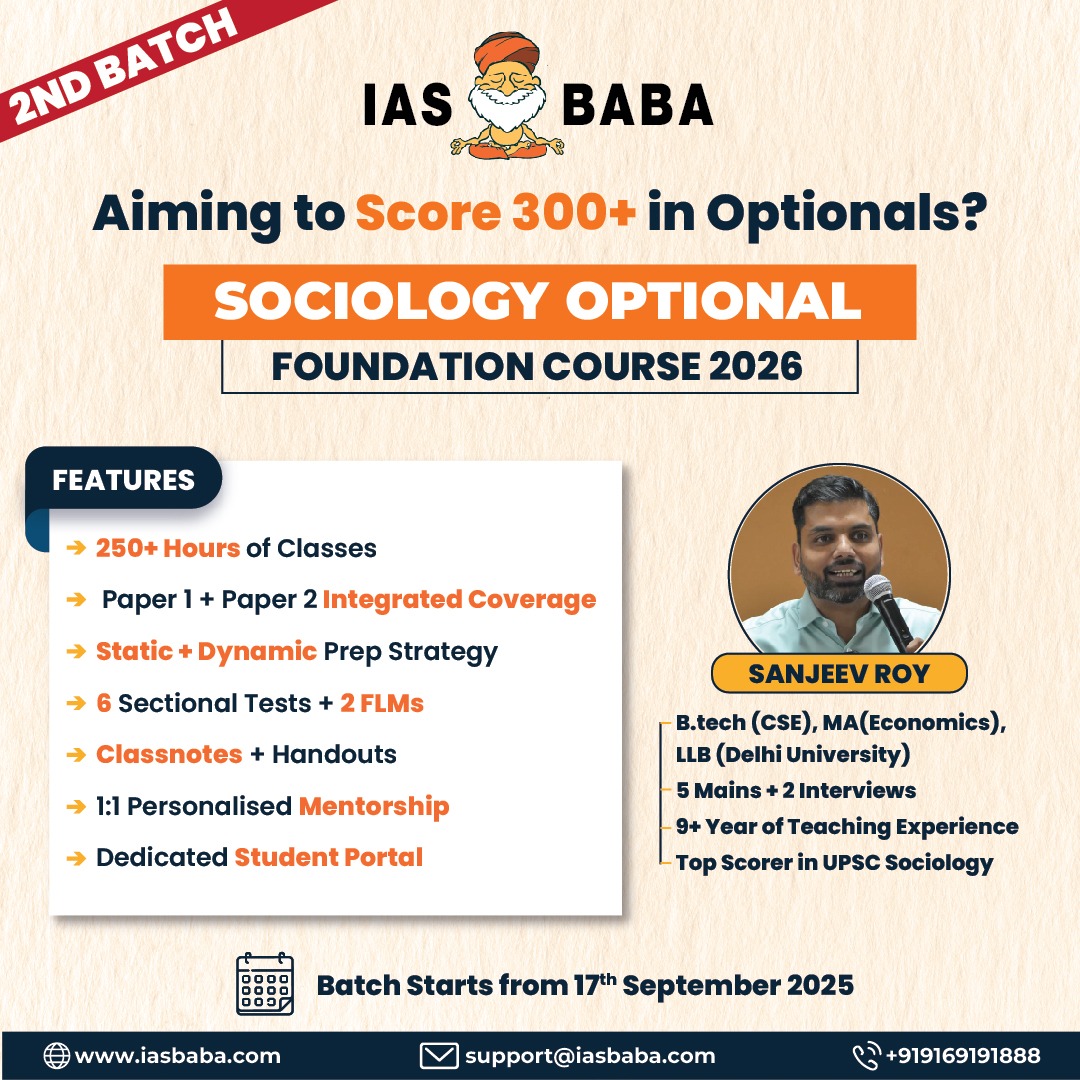IASbaba's Daily Current Affairs Analysis
Archives
(PRELIMS Focus)
Category: POLITY
Context: A delegation of 10 MLAs from the Manipur Assembly met the Governor of the State and pressed for the formation of a viable government in Manipur that has been under President’s Rule since February 2025.
Learning Corner:
How is President’s Rule Imposed in India?
President’s Rule refers to the suspension of a state government and the imposition of direct central (Union) government rule in a state. This is governed by Article 356 of the Indian Constitution.
Grounds for Imposition
President’s Rule can be imposed under the following circumstances:
- The President is satisfied that the state government cannot be carried on in accordance with the provisions of the Constitution. This satisfaction can arise from:
- A report from the state’s Governor, or
- Other reliable sources of information.
- The state legislature fails to elect a Chief Minister within the time prescribed by the Governor.
- Breakdown of a coalition government, leading to the Chief Minister losing majority support and failing to prove majority in the Assembly.
- Loss of majority in the Assembly due to a vote of no-confidence.
- Elections cannot be held due to war, epidemic, or natural disaster.
- Failure of the state government to comply with directions from the Union government (Article 365).
Procedure
- Proclamation: The President issues a proclamation imposing President’s Rule in the state.
- Parliamentary Approval: The proclamation must be approved by both Houses of Parliament within two months by a simple majority.
- Duration: Once approved, President’s Rule lasts for six months and can be extended every six months up to a maximum of three years, with each extension requiring fresh parliamentary approval.
- Extension beyond one year is permitted only if:
- A national emergency is in operation, or
- The Election Commission certifies that elections cannot be held in the state.
- Extension beyond one year is permitted only if:
- Administration: The state’s Council of Ministers is dissolved, and the Governor administers the state on behalf of the President, often with the help of appointed administrators.
- Revocation: The President can revoke President’s Rule at any time without parliamentary approval.
Key Points
- The President cannot assume the powers of the High Court during President’s Rule.
- The Supreme Court’s judgment in S. R. Bommai v. Union of India (1994) placed restrictions on arbitrary imposition of President’s Rule.
- The state legislative assembly may be suspended or dissolved, and Parliament may assume legislative functions for the state.
In summary, President’s Rule is a constitutional mechanism for the central government to take over a state’s administration when its constitutional machinery fails, following a detailed process with parliamentary oversight and judicial safeguards.
Source : the hindu
Category: GEOGRAPHY
Context A devastating landslide, triggered by heavy rainfall, struck an Indian Army military camp at Chhaten near Lachen in North Sikkim
The incident resulted in the tragic deaths of three Army personnel:
Rescue Efforts
- The Army launched immediate rescue operations, but weather and rugged terrain have severely hampered progress.
- Four personnel with minor injuries have been rescued.
- Senior military officials, including the Commander of the 33 Corps, visited the site to supervise the ongoing operations.
Broader Impact
- The landslide has triggered widespread disruption across North Sikkim.
- Over 1,600 tourists were stranded due to associated landslides and flash floods.
- Evacuation efforts are ongoing, but certain regions remain inaccessible.
Summary
This tragic event highlights the vulnerability of high-altitude regions like North Sikkim to climate-related disasters, particularly during the monsoon season. The incident also underscores the challenges faced by rescue teams in remote, weather-impacted terrain.
Learning Corner:
India faces a wide variety of natural and human-induced disasters due to its vast geography, diverse climate zones, dense population, and rapid urbanization. Below is a categorized overview of different types of disasters in India, along with examples:
Natural Disasters
- Earthquakes
- Common in: Himalayan belt, Northeast India, Kutch region (Gujarat), parts of Gangetic plains
- Example: 2001 Bhuj Earthquake (Gujarat) – over 20,000 dead
- Floods
- Frequent in: Bihar, Assam, West Bengal, Uttar Pradesh, Kerala
- Causes: Heavy rainfall, river overflow, poor drainage
- Example: 2018 Kerala Floods – devastating impact on infrastructure and life
- Cyclones
- Common in: Eastern coast (Bay of Bengal) and Western coast (Arabian Sea)
- Example: Cyclone Amphan (2020) – hit Odisha and West Bengal
- Example: Cyclone Biparjoy (2023) – impacted Gujarat coast
- Landslides
- Occur in: Himalayan region, Northeast, Western Ghats
- Triggered by: Heavy rainfall, deforestation, earthquakes
- Example: 2023 Sikkim landslide – military casualties and widespread disruption
- Droughts
- Frequent in: Maharashtra, Rajasthan, Karnataka, Andhra Pradesh
- Causes: Monsoon failure, groundwater depletion
- Impact: Crop loss, water scarcity, migration
- Heatwaves
- Rising in frequency due to climate change
- Common in: North and Central India (e.g., Delhi, Rajasthan, Bihar)
- Example: 2015 Heatwave – over 2,000 deaths reported
- Tsunamis
- Rare but possible due to proximity to seismic zones
- Example: 2004 Indian Ocean Tsunami – massive impact in Tamil Nadu, Andhra Pradesh, and Andaman & Nicobar Islands
- Cold Waves
-
- Occur in: North India (Punjab, Haryana, Uttar Pradesh, Bihar)
- Impact: Deaths due to hypothermia, especially among vulnerable populations
Source : the hindu
Category: ENVIRONMENT
Context : 2025 Lion Census : 32% Population Rise
Learning Corner:
The 2025 Asiatic lion census in Gujarat recorded a 32% population increase, rising from 674 in 2020 to 891 in 2025. This is a significant conservation milestone, reflecting decades of dedicated efforts. However, experts warn that numerical growth alone does not ensure the long-term survival of the species.
Key Findings from the 2025 Census
- Total Population: 891 lions (up 32.2%)
- Distribution: 44% now live outside protected forests (in farmlands, wastelands, human-dominated areas)
- Range Expansion: Lions now inhabit 35,000 sq km across 11 districts (17% increase in range)
- New Satellite Populations: Barda Wildlife Sanctuary, Jetpur, Babra-Jasdan
- Core Area: Gir National Park and adjacent sanctuaries remain central but are near capacity
Why Numbers Alone Aren’t Enough
- Habitat Limitations
- Over 40% of lions live outside forest zones with less prey and higher risk.
- Fragmented and degraded habitats can’t sustain stable populations long-term.
- Rising Human-Lion Conflict
- Increasing encounters in farms and near human settlements raise chances of conflict.
- Railways, highways, and urban infrastructure fragment wildlife corridors and increase accidental deaths.
- Single Population Risk
- All wild Asiatic lions live in and around the Gir landscape.
- Makes them vulnerable to disease outbreaks, floods, or forest fires—one event could decimate the population.
- Genetic Concerns
- Low genetic diversity due to inbreeding reduces resilience to disease and climate stress.
- A genetic bottleneck limits evolutionary adaptability.
- No Second Wild Population
- Despite longstanding expert consensus, no viable second free-ranging population exists outside Gujarat.
- Plans to relocate lions (e.g., to Kuno National Park, Madhya Pradesh) remain stalled.
Conservation Experts Recommend:
- Expand and Connect Habitats: Create ecological corridors and expand protected areas beyond Gir.
- Establish a Second Population: Translocate lions to a genetically and ecologically suitable area to reduce the single-population risk.
- Minimize Human-Wildlife Conflict: Implement better compensation, awareness programs, and wildlife-friendly infrastructure like underpasses.
- Improve Scientific Monitoring: Strengthen population estimates, disease surveillance, and genetic studies.
Conclusion
While the 2025 lion census is a conservation success story, it must not breed complacency. True security for the Asiatic lion requires strategic, science-driven action—habitat expansion, conflict mitigation, genetic management, and the long-pending creation of a second wild population. The focus now must shift from counting lions to securing their future.
Asiatic Lion – A Brief Overview
The Asiatic Lion (Panthera leo persica) is a critically important subspecies of the lion, found only in India and distinct from its African counterpart.
🔹 Key Facts:
| Attribute | Details |
|---|---|
| Scientific Name | Panthera leo persica |
| Habitat | Gir Forest, Gujarat, India |
| Current Population | 891 (2025 Census) |
| IUCN Status | Endangered |
| Global Range | Exclusive to India (only wild population) |
| Main Threats | Habitat loss, inbreeding, human conflict, disease |
Distinct Features:
- Smaller and leaner than African lions
- Less developed mane (especially in males)
- Prominent skin fold along the belly
- Live in smaller groups (prides)
Source: THE INDIAN EXPRESS
Category: INTERNATIONAL
Context : On June 1, 2025, Ukraine launched its most daring drone offensive, Operation Spider’s Web, representing a major leap in asymmetric warfare.
Decoding the context: This operation showcased how low-cost, high-tech tactics can inflict serious damage on a militarily superior adversary.
Learning Corner:
Operation Spider’s Web: A Game-Changer in Drone Warfare
- On June 1, 2025, Ukraine launched its most daring drone offensive, Operation Spider’s Web, representing a major leap in asymmetric warfare. After 18 months of covert planning, Ukraine smuggled 117 FPV drones into Russian territory using trucks with hidden compartments. These drones were remotely activated to strike at least five high-security Russian airbases, some as far as 4,000 km into Siberia.
Damage Reported:
- 41 Russian military aircraft destroyed or damaged
- Estimated $7 billion in losses to Russia’s air assets
- Key Targeted Assets: Strategic bombers, surveillance aircraft, radar systems
- This operation showcased how low-cost, high-tech tactics can inflict serious damage on a militarily superior adversary. It exposed the vulnerability of critical military infrastructure, regardless of distance or security.
Diplomacy Overshadowed: The Second Round of Talks
- Just hours after the strikes, Russian and Ukrainian officials met in Istanbul for the second round of peace talks. The talks:
- Lasted less than an hour
- Yielded no major breakthroughs except for discussions on another prisoner swap
- Reflected deep mistrust and hardened positions on both sides
- The timing of the drone strikes added a layer of tension, with Russia labeling the attack as a “terror act” and vowing retaliation.
Drones vs Diplomacy: The Shifting Battlefield Reality
- The dual developments of a groundbreaking drone strike and stalled diplomacy symbolize the new face of modern conflict:
- Technology-Driven Warfare: Ukraine has demonstrated that innovation and stealth can level the battlefield even against larger militaries.
- Diplomatic Paralysis: Ongoing hostilities and escalation tactics make genuine negotiations nearly impossible.
- Narrative War: While Ukraine frames the drone strikes as leverage for peace, Russia sees it as provocation.
- Ukrainian President Volodymyr Zelenskyy hailed the operation as a historic milestone, hoping it would force Russia to the table. Yet, most analysts believe the attacks may harden Russia’s stance rather than soften it.
Key Takeaways
- Asymmetric tactics like drones are reshaping the landscape of warfare.
- Diplomacy is increasingly fragile amid strategic escalations and mutual suspicion.
- Ukraine’s operation reaffirms how non-conventional methods can yield strategic wins—but may also escalate geopolitical risks.
Conclusion
Operation Spider’s Web marks a turning point—not just in how wars are fought, but in how difficult it is to reconcile military innovation with diplomatic resolution. As drones dominate the skies, the path to peace becomes ever more complicated on the ground.
Source : the Indian express
Category: INTERNATIONAL
Context : President Droupadi Murmu is hosting President Santiago Peña Palacios of Paraguay on a historic State Visit to India from June 2 to 4, 2025
Learning Corner:
This marks President Peña’s first-ever visit to India and only the second time a Paraguayan head of state has visited, underscoring the deepening relationship between the two countries.
Key Highlights
High-Level Engagements
- President Peña is accompanied by a high-level delegation including ministers, officials, and business leaders.
- He is holding delegation-level talks with Prime Minister Narendra Modi to enhance cooperation across political, economic, and cultural domains.
Ceremonial Welcome
- The visit commenced with a Guard of Honour at Rashtrapati Bhavan.
- President Murmu is hosting a State Banquet in his honour.
- Meetings are scheduled with Vice President Jagdeep Dhankhar and External Affairs Minister Dr. S. Jaishankar.
Focus Areas for Cooperation
- Sectors Discussed: Trade, agriculture, healthcare, pharmaceuticals, and information technology.
- Global Issues: Shared perspectives on UN reforms, climate change, renewable energy, and counter-terrorism.
- Both leaders emphasized the importance of collaboration in tackling cybercrime, drug trafficking, and organised crime.
Global South Solidarity
- Prime Minister Modi highlighted the strategic partnership within the Global South, noting common development goals and challenges.
Mumbai Leg
- In Mumbai, President Peña will engage with state leaders, startup ecosystems, business communities, and tech innovators—aiming to strengthen bilateral economic and innovation partnerships.
Significance of the Visit
President Peña referred to India as an “admirable partner, respected friend, and source of inspiration.”
This visit:
- Reinforces the growing diplomatic warmth between India and Paraguay
- Paves the way for expanded economic and strategic engagement
- Reflects mutual interest in shaping a more balanced and representative global order
This State Visit marks a milestone in India–Paraguay ties, laying a strong foundation for a deeper, diversified, and future-focused partnership.
Source: PIB
(MAINS Focus)
| Date: 3-06-2025 | Mainspedia | |
| TOPIC: President Rule in Manipur | GS Paper II – Polity | |
| Introduction (Context)
A delegation of 10 MLAs from the Manipur Assembly met the Governor of the State and pressed for the formation of a viable government in Manipur that has been under President’s Rule since February 2025. This development rekindles the debate on the use and misuse of Article 356 of the Indian Constitution. |
||
| What is President Rule? |
|
|
| Impact |
|
|
| President rule in Manipur |
|
|
| Misuse of President rule |
|
|
| S.R Bommai case |
|
|
| Value Addition |
|
|
| Conclusion
President’s Rule is a constitutional mechanism designed for rare and exceptional breakdowns in governance however; its historical misuse has often raised concerns about political motives and erosion of federal values. In Manipur’s case, restoring an inclusive, democratically-elected government is critical not just for governance, but for rebuilding trust in constitutional processes. |
||
Mains Practice Question
Q “The imposition of President’s Rule must be an exception, not the norm.” Critically analyse (250 words, 15 marks)
| Date: 3-06-2025 | Mainspedia | |
| TOPIC: FPV Drones in Modern Warfare | GS Paper III – Science and Technology | |
| Introduction (Context)
In a landmark drone operation dubbed “Operation Spider’s Web,” Ukraine recently launched FPV (First-Person View) drones deep into Russian territory, reportedly destroying over 40 aircraft across five locations, some nearly 4,000 km from the Ukraine-Russia border. This marks the most extensive drone strike since the onset of the war in 2022. |
||
| What are FPV Drones? |
|
|
| How Are They Used in Combat? |
|
|
| Advantages |
|
|
| Disadvantages |
|
|
| Value Addition | Reconnaissance drone
|
|
| Conclusion
The Ukraine-Russia war underscores the rise of drones, especially FPV drones, as game-changing tools in modern warfare. Their low cost, high precision, and minimal risk to human lives have made them indispensable. As more nations race to integrate drones into their defence strategies, the future battlefield will likely be shaped by code, cameras, and controllers more than conventional boots on the ground. |
||
Mains Practice Question
Q Discuss the role of First-Person View (FPV) drones in modern warfare with reference to the Russia-Ukraine conflict. Examine the implications of increasing drone proliferation on India’s national security and defence preparedness. (250 words, 15 marks)
Daily Practice MCQs
Today’s – Daily Practice MCQs’ will be updated in our “Daily Current Affairs Quiz” section on our website
Please click on the below link














